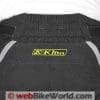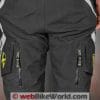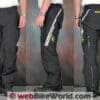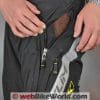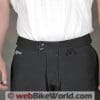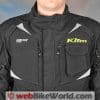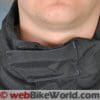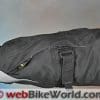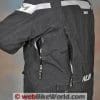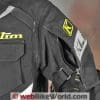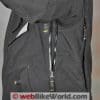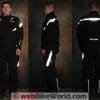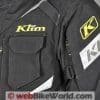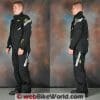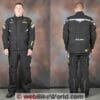The new Klim Badlands Pro jacket and pants outfit is the very definition of “extreme duty” adventure touring gear — no doubt about it. The jacket and the pants provide a go-anywhere, highly protective “suit of armor” feel. It is also surprisingly comfortable in the hottest of summer weather.
There are a few nits to pick however… But this is the current must-have outfit for rugged adventurers, off-roaders, back road tourers and wannabes like me.
August 16, 2011 – I just learned today from Klim that the jacket and pants we had were pre-production versions of the Badlands Pro. Apparently, some of the features have been improved and I will note them here.
For the record, we’ve been using this this gear for nearly three months.
I emailed my contacts at Klim last week, as we were working on the final edits for this review, to ask if there were any changes, updates, specifications, etc. that I should know about before proceeding.
Unfortunately, the information did not reach me in time, thus these updates.
We normally would not knowingly report on prototype or pre-production items and if we did, it would be noted in the review. In this case, the outcome might have been significantly different.
From the Klim designers, here is a list of the changes and improvements that have been made to the Badlands Pro jacket that will be produced and sold, starting in November of this year:
- The small piece of hook-and-loop at the collar has been made twice as big, and there has been a hidden snap added for security.
- The collar flaps can be held open with the added Velcro tabs we added the shoulders.
- The snap at the bottom of the center front zipper has been made hidden (internalized).
- The arm adjusters have been made about 4.5 cm shorter and more Velcro has been added to cinch down the arms more.
- The arm adjuster locations have been moved towards the triceps more for more adjustability.
Klim has developed quite a reputation with hard-core off-roaders and snowmobilers, who have relied on the brand for no-compromise outdoor gear.
Their new lineup has also garnered much attention with street riders, adventure tourers or anyone looking for rugged and high-quality gear designed to take as much abuse as you can give it and come back for more.
The company — pronounced “climb” — started by making custom apparel for the ski patrol and search and rescue types in the northwestern U.S. As the story goes, people took notice and started buying the gear for snowmobile use.
And since rugged outdoor gear is just as useful for off-road motorcycle riding, that became a natural next step.
I first became aware of the brand at the 2008 Dealer Expo in Indianapolis, when they had a small display of cool-looking enduro jackets that grabbed my attention.
At the time, the company was apparently just starting to get serious about motorcycle gear, so I made a mental note to keep track and see what transpires.
Fast-forward to the 2011 Dealer Expo (report), where Klim had a big and very busy display. The big news was their new Badlands Pro jacket and pants, described here, and the also-new Latitude jacket and pants.
Both of these outfits solidify the company’s move into the burgeoning adventure touring market. The Badlands Pro outfit slots in just under the Klim Adventure Rally jacket and pants
The Badlands Pro and Latitude products now span the gap between the breathtaking $1,300.00 list price of the Adventure Rally line and the rest of the Klim lineup.
Klim also has several much less expensive choices designed for true off-roading rather than street, adventures and touring.
You can spend as little as $200 and still climb into a Klim (sorry) outfit with the Inferno jacket and pants combo.
But comparing the Badlands Pro outfit to the Inferno is like comparing a Ducati Diavel (info) to the BMW kid’s bicycle (info).
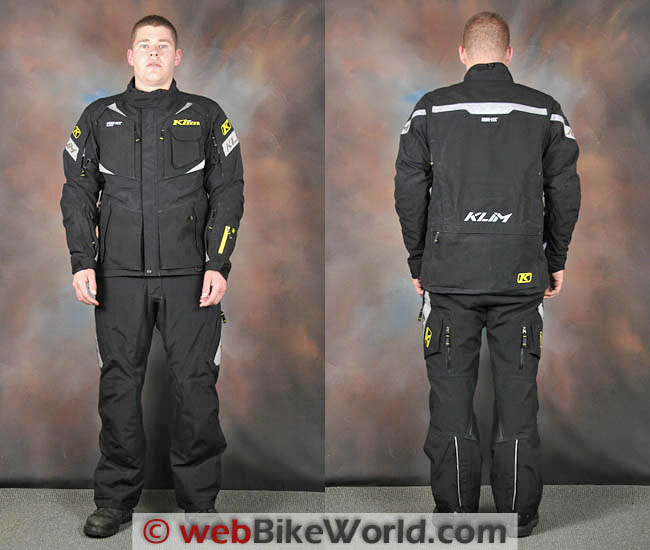
The Klim Badlands Pro Outfit
The Badlands Pro outfit is a tough, rugged and well-made set of gear that will surely take whatever abuse you can give it and come back for more.
It looks better — and badder — in the all black version than it does in gray and black.
And while it may not be color-matched to your 2011 Gold Wing, it would work just as well on that bike as it would on a fully farkled KTM 990 Adventure R.
Of course, you’re much more likely to see the Badlands Pro outfit on the KTM owner, but the point here is that the Badlands Pro is one more move by Klim into the not-so-hardcore real world that most of us inhabit.
The company seems pretty sensitive about this; after all, when you’ve built your reputation with the way, way off-track crowd, you have to be pretty careful about not looking too L.L. Beanish.
Don’t worry, Klim — no one’s going to mistake the Badlands Pro outfit for a Casco Bay windbreaker.
Phrases like “heavy-duty” and “wearable body armor” and “built like a tank” come to mind when you throw the Badlands Pro jacket over the shoulders.
Where the Rev’it Cayenne Pro jacket (review) or Defender GTX jacket (review) are more street than trail, the Badlands Pro is just the opposite.
The next time you’re exploring the Tunguska or if you’re planning on taking the KTM out for a spin on December 21, 2012,, the Badlands Pro outfit is what you’ll want to wear.
It’s designed as a true adventure touring and off-roading outfit first and foremost. “It’s like aBritish Motorcycle Gear Adventure jacket (review) on steroids”, said Burn.
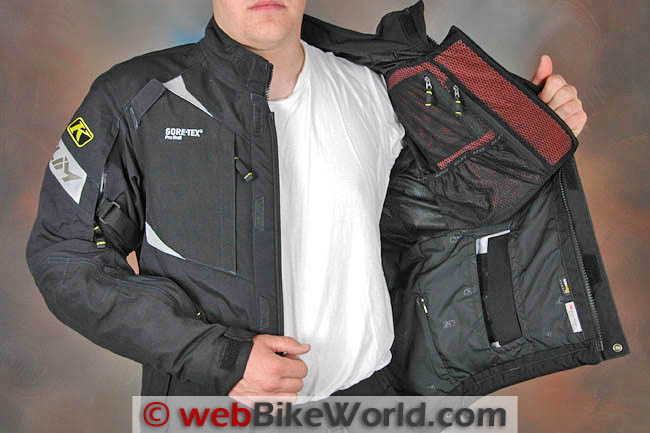
Tailoring and Overall Quality
The construction quality, stitching and detailing on the Badlands Pro outfit is outstanding, with nary a loose thread to be found, either inside or out.
Klim said that the thread material is a special type of nylon core with a double-wound external sheathing.
It does appear different from most stitching; it has a slightly blue color that can be seen under close inspection in certain types of lighting.
Most of the stitching is double row and the cut and patterns were designed specifically with the adventure touring rider’s movements in mind.
This helps to make both the jacket and pants feel very comfy, even off the bike and really not all that much different than wearing a street jacket and a pair of loose-cut street jeans.
Stiffer, perhaps, but surprisingly comfortable compared to other motorcycle riding outfits that include a 3/4-length jacket.
Many of the seams are reinforced and bar tacked at the stress points, such as the pocket corners; the adjustment strap ends; and the end of each vent opening.
Bar tack stitching reinforcement is usually found only on top-of-the-line motorcycle garments because it requires a separate manufacturing process after all the other stitching is completed.
The rugged no-nonsense appearance of the Badlands Pro probably hides some of the elegance and quality of the construction and stitching, but it’s there and that’s one of the things you’re paying for.
Not as successful — and surprising in a different way — are a few of the trim details, like the too-small pieces of hook-and-loop closures used throughout the jacket.
The tall 60 mm collar with its tricot-lined neck is very comfortable, but it has only a small piece of hook-and-loop to close the neck in front.
There is a size adjustment on the collar with a threaded cinch rope through the top seam. It pulls the tall (2-3/8″) collar tight and it has one of those spring-loaded push buttons to hold the adjustment string.
There are limited options for the collar.
The flap can’t be folded back on to the jacket and attached to leave the collar open like it can on the Rev’it jackets, nor can the collar or upper neck be secured in an open position like the BMG Adventure jacket design allows.
[UPDATE: See the Editor’s Note at the beginning of this article. The hook-and-loop at the collar has been made twice as big, and there has been a hidden snap added for security on the production version, according to Klim.Also, the production version has additional hook-and-loop tabs that are added to secure the collar in the open position.]
So the collar design on the Badlands Pro is a mixed blessing.
It’s about as soft and comfortable as they come, but the adjustment system seems a bit crude and the tiny piece of hook-and-loop seems a bit out of place on a $900.00 jacket, as you can see in the photo below.
A fully adjustable collar is expected on almost any motorcycle jacket today, regardless of type.
On a true adventure touring jacket, the collar should at least have a snap or a fixture to keep it open — or even a zipper to allow it to be detached.
This is an important comfort factor for slower off-road riding in hot weather and I’m kind of surprised Klim missed this detail. I guess it doesn’t get hot in Idaho!
[UPDATE: The collar on our pre-production version can be secured open on the left side by using the hook-and-loop tab located near the shoulders as seen in the photos.Although there is a loop on the right side also, the collar on that side isn’t really long enough to reach it.]
Just four small 40 mm long strips of hook-and-loop are used to secure the main flap in front of the jacket that covers the zipper.
A single plastic-covered metal snap lives at the bottom of the hem; the rest of the flap secures with the hook-and-loop sections. I just think this seems a bit out of place on a jacket of this type.
[UPDATE: See the Editor’s Note at the beginning of this article. The snap at the bottom of the center front zipper has been made hidden (internalized) on the production version, according to Klim.]My final hook-and-loop issue is with the sleeve cuffs, which secure with a very simple hook-and-loop flap.
The sleeve cuff doesn’t include a dart either. It’s not that hook-and-loop isn’t used for sleeve cuffs; in fact, that is probably the most common closure found on motorcycle jackets.
It’s just that the Badlands Pro design is so basic and the pieces of hook-and-loop used are so small that it just doesn’t seem to be the type of detailing expected on a high-end jacket.
I also have my doubts about the longevity of the small sections of hook-and-loop when exposed to the rigors of true off-road riding.
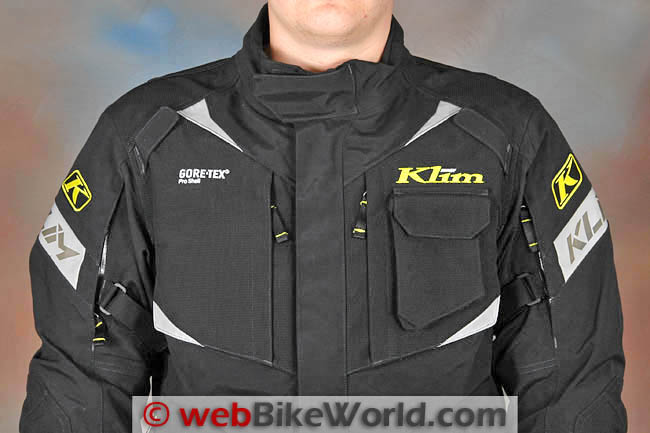
The “High Mobility Fit”
The Badlands Pro jacket and pants are made from the current ne plus ultra of motorcycle clothing material; Gore-Tex 3-layer Pro Shell.
This is the material used in the Rev’it Defender GTX outfit (review) and it’s been showing up in other high-end motorcycle garments, so regular webBikeWorld readers are probably aware of its many benefits.
I’ll discuss this in more detail in the next section.
One of the most defining features of the Badlands Pro jacket and pants is the slightly loose fit.
That is by design, optimized for the different types of movements and body positioning an off-road or adventure touring rider experiences.
In this regard, the Badlands Pro jacket (and pants) are indeed reminiscent of the BMG Adventure outfit.
It doesn’t have a waterproof or insulating liner and for this type of gear, that’s actually a good thing, as noted also in the BMG Adventure review.
The Badlands Pro outfit is designed with adventure touring in mind; Klim says it features their “high-mobility active fit patterning”.
This type of fit — and the absence of the liners — makes the outfit much more comfortable (and reasonable) for true off-road bashing than street-oriented gear.
It’s derived from true off-road and enduro experience and it is a bit unexpected for riders used to snug-fitting street and sport clothing.
Choosing a Size
The jacket shown here is a size large, sent by Klim after I provided my measurements.
I’m used to snug-fitting street/sport gear, so I thought it was way too big at first until the first time I took the bike off road, when I realized it was only just a little bit big. Is that an oxymoron?
The extra room is needed in an adventure touring jacket because of the the frequent up/down movements needed to guide the bike.
The size large feels like it should fit a 44 to 46 inch chest size, but the Klim sizing chart lists the Badlands Pro jacket in size large as fitting a 42 to 45, which is an unusually wide range for a size large.
I’m a 43/44 and the model in the photos is a 45 and you can see the jacket looks a bit big even on him, so I think 43 at the small end would be correct and 46 at the large end.
The size large jacket would definitely be too big for a 42 in my opinion.
The sleeves feel longer than average for a size large; Klim says they are 30 to 32 inches for the size large and, in fact, that’s about what the measuring tape shows.
Probably the looser-by-design fit tends to make the sleeves feel longer than normal, especially when the jacket is worn over something light, like a T-shirt or moisture-wicking long sleeve undershirt.
I take a 34 inch arm in a shirt and I originally guessed the sleeves were maybe 35 or even 36 inches, but they’re not.
I’ve seen some stock photos from Klim of models wearing the jacket and the sleeves seem a bit long on them also, so apparently it’s all part of the design.
This isn’t a problem, just an observations and when I’m riding an adventure touring bike like theSuzuki DR650 (blog), I don’t notice that the sleeves feel longer than normal.
So knowing all this, you should be read to order, with the caveats mentioned above.
But expect that the “high mobility active fit” will feel different at first and if you’re at the low end of the size range, you may want to consider moving down a size.
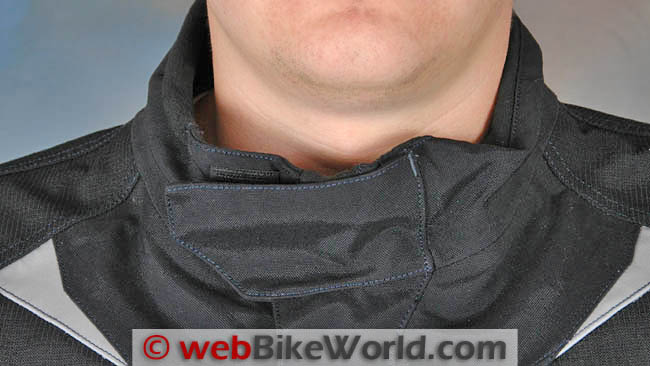
Badlands Pro Jacket Shell and Sleeve Adjusters
One thing that is obviously important with “high mobility fit” garments is adjustability and armor placement.
This type of slightly loose when compared to snug sport/track gear is all well and good, but adventure tourers and off-road riders still need to ensure that the armor and padding will be there when they need it.
In fact, since a tip-over is a fact of life when riding off the beaten path, ensuring a system that will properly adjust the jacket to keep the armor in place is even more crucial.
This is why we decided to take a detailed look at the shell and arm adjustment features of the Badlands Pro jacket.
[UPDATE: See the Editor’s Note at the beginning of this review. On the production version, the arm adjusters have been made about 4.5 cm shorter and more hook-and-loop has been added, according to Klim.The arm adjuster locations have also been moved towards the triceps more for more adjustability.]
Jacket Shell Body and Waist Adjustment
Look closely at the photos and you’ll notice that the Badlands Pro jacket doesn’t have an external waist adjustment. In this case, that’s a plus.
There is a waist adjuster all right, but it’s combined with an interesting and clever surprise.
The jacket includes a very nice d3O brand, Level 2 full-sized back protector, which has a waist belt that is cleverly incorporated into the jacket shell on the inside.
Back Protector Included
This is the first motorcycle jacket I can recall that has a high-quality back protector included and it’s very nicely incorporated into the design, with a waist belt that weaves through a slot in the mesh jacket liner.
As you put on the jacket, you’re also putting on the back protector. No extra fuss or bother.
So this means that the back protector will always be there when you need it, rather than hanging on a rack back home.
A secondary function of the waist belt attached to the back protector is to serve as a cinch or waist adjustment, which helps to keep the jacket shell more snugly in place on your body.
It works beautifully to ensure the Badlands Pro keeps that “high mobility” fit and feel, while also providing an internal structure that protects the rider.
And a Chest Protector…
I’m getting ahead of myself here by describing the protectors before I get to the armor section below, but as long as I’m at it, I might as well let you in on another nice surprise: the Badlands Pro also includes a chest protector.
It too is a very clever design that incorporates a special Dow two-piece chest protector into the left and right sides of the chest.
Again, it’s always there — zip up the jacket and you have a functional built-in chest protector. Again no fuss, no bother, you don’t have to remember to do anything special.
Very cool and it makes the wimpy padding installed in the back of the high-end Rev’it outfits more of an issue even than it was before.
One more adjustment can be found in a synthetic rope built into the hem along the bottom of the jacket. It has a nylon spring-loaded stop that holds the adjustment as it’s cinched tight.
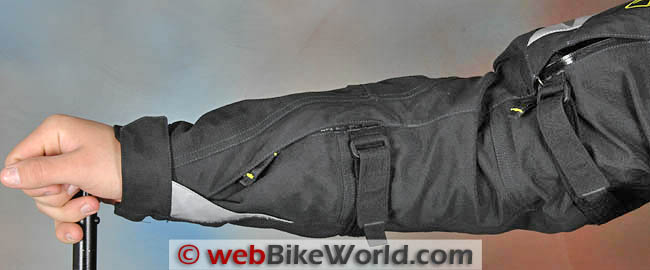
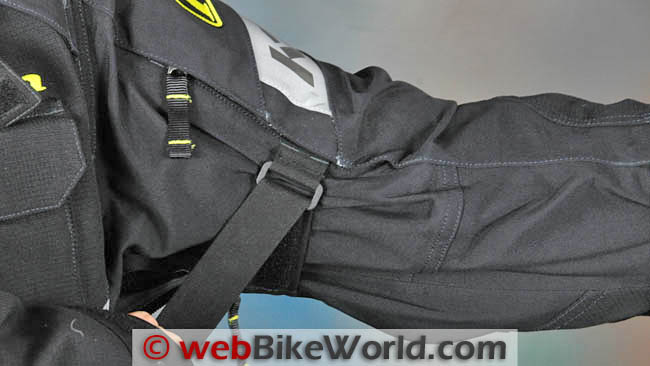
Sleeve Adjusters
Also important is the ability to adjust the sleeves to keep the armor and padding in place over the elbows and forearms.
The Badlands Pro has dual arm adjusters on each side; one is located at the bicep and the other around the forearm.
The adjusters on this jacket are made from 1-1/4″ (22.5 mm) wide, double-layer material strap that feeds through a square nylon D-ring on one end and uses hook-and-loop for attachment.
Both ends of the attachment strap are bar-tacked to the jacket sleeve.
These adjusters may pose a problem for some though.
The basic problem is this: The adjustment straps are probably twice as long as necessary and they have too much “loop” and not enough “hook” to work correctly.
There isn’t enough adjustment to make the arms tight enough to keep the elbow armor in place.
Now this may be partly caused by the slightly larger than expected sizing of the jacket, but remember that Klim says the jacket will fit a 42 to 45 and the amount of sleeve adjustment that the adjusters provide doesn’t seem proportionate.
It’s as if they designed the arm adjustment straps with a couple of liners in place inside the jacket — but then took out the liners.
For example, the bicep adjuster strap provides only about 2 inches of adjustment before the “hook” sections run off the end of the “loop”.
The forearm adjusters have the same problem. They have about 4-3/4″ of “loop” but only two 3/4″ sections of “hook”, located at the last 2″ or so of the strap end.
So there isn’t enough adjustment, either at the bicep or forearm to make the arms snug enough for a “normal” sized arm dimension.
The problem isn’t as acute if the rider is wearing insulating layers, but in the summer, if the rider is only wearing a T-shirt or a moisture-wicking undershirt like the Spark moisture-wicking undershirt (review), this may be an issue.
I think the sleeve adjusters should have been designed with about a 50/50 distribution of “hook” and “loop”, which would have given a wider range of adjustment
Bottom line? An adjuster must ensure that the entire range of adjustment is available. Let’s hope they fix it in a running production modification.
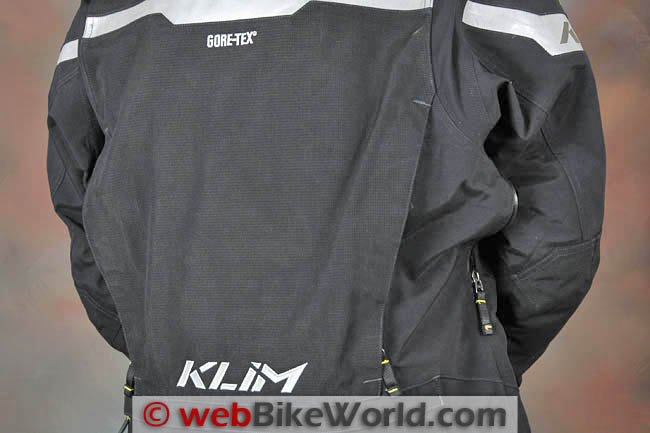
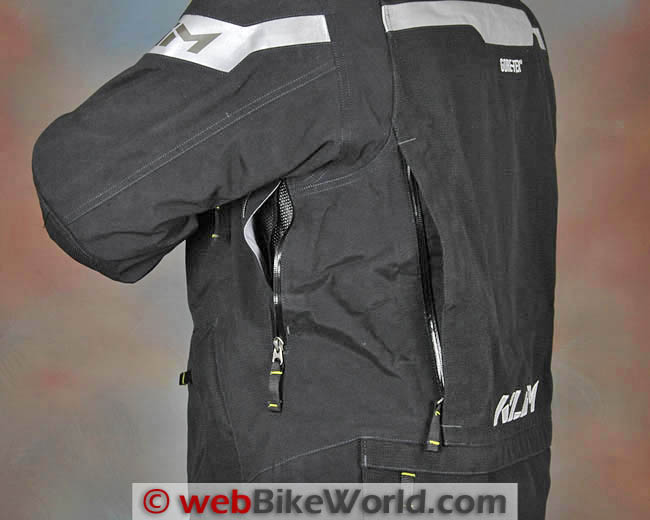
Badlands Pro Jacket Construction Features
Gore-Tex 3-Layer Pro Shell
The Badlands Pro jacket and pants are made from the very high-end Gore-Tex 3-layer Pro Shell material.
This is also used in the Rev’it Defender GTX outfit (review), so I won’t go into a lot of detail here other than to note that the shell carries the full Gore-Tex “Guaranteed to Keep You Dry” pledge, just like the Rev’it Defender GTX and the Rev’it Everest GTX (review) outfit.
Our experience with the latest Gore-Tex products have been very positive.
All of the current membranes and materials used in motorcycle gear are described in this Gore-Tex report and the Pro Shell is claimed to be their “most rugged, most fabrics for extended and extreme conditions”.
The Pro Shell material is:
“Designed for touring and off-road adventure touring riders who will be exerting a lot of energy and perspiring during their off-track adventures and who require the ultimate in breathability, moisture outgassing and protection”, according to Gore-Tex.
The bottom line is that the Pro Shell is the current top-end Gore-Tex product.
It’s expensive, but it provides the ultimate in water resistance and breathability without requiring an inner waterproof lining.
Cribbing from the webBikeWorld report, one of the unique features of the three-layer Pro Shell is that the outer shell is bonded directly to the Gore-Tex membrane.
So there’s no membrane visible on the inside of the fabric; the shell has the Gore-Tex membrane bonded to the inside and then a special textile liner is bonded to the inside of the Gore-Tex membrane, facing the rider.
This means that the outer shell is completely waterproof and water will not soak into the shell itself.
This is the “holy grail” of motorcycle clothing for some.
Many webBikeWorld readers have been hoping for a jacket and pants that will resist water at the outermost layer, and this is it.
But as I also mentioned in the report, you will pay for the privilege of owning this technology and the Badlands Pro jacket and pants are no exception.
Comfort Notes
The Badlands Pro doesn’t need the waterproof liner it doesn’t have because it uses the ultra-high-end Gore-Tex 3-layer Pro Shell (report).
And if you want an insulating liner, shirt- or pants-based armor, heated gear, etc., you can mix and match.
For example, add your own motorcycle underwear (reviews) and polar fleece layers, which gives more flexibility and choice to the rider.
The shell-only approach is actually a good design feature for this type of jacket, considering its intended use.
Note that the jacket and pants do have an attached perforated liner of the type usually found in motorcycle jackets. It’s comfortable and suitable for use against the skin when wearing only a T-shirt underneath the shell.
The looser fit of the jacket also allows air to circulate more freely.
This, combined with the excellent moisture transporting properties of the Gore-Tex Pro Shell, makes it comfortable to wear the Badlands Pro through a wider range of temperatures than one might expect.
And that includes a surprising amount of comfort in very hot weather.
It also is a better solution for off-road and adventure riding, when you may be riding slower or in warmer weather and with more exertion due to the constant up and down on the foot pegs.
In fact, I think the Gore-Tex membrane is at its best here.
That is due in no small part to the absence of the liners, because this allows complete freedom for the Pro Shell to transport the body’s moisture unimpeded to the surface of the jacket shell, where it is evaporated.
I experienced a dramatic demonstration of this effect the other day, when I debated wearing the outfit in sunny weather that started out at 84 degrees in the morning and ended up around 90 by noon.
By all rights, wearing a black-colored outfit like this would be out of the question. But as it turned out, I was very comfortable and I definitely noticed the difference — a wonderful surprise.
I did feel the heat when I stopped to take photos, but even then it wasn’t unbearable by any means.
And as soon as the bike started moving, the sweat magically disappeared and I could feel the air circulating through the jacket and pants.
This hot-weather comfort is certainly enhanced by the excellent ventilation system in the Badlands Pro jacket (and pants) that I’ll describe in the next section.
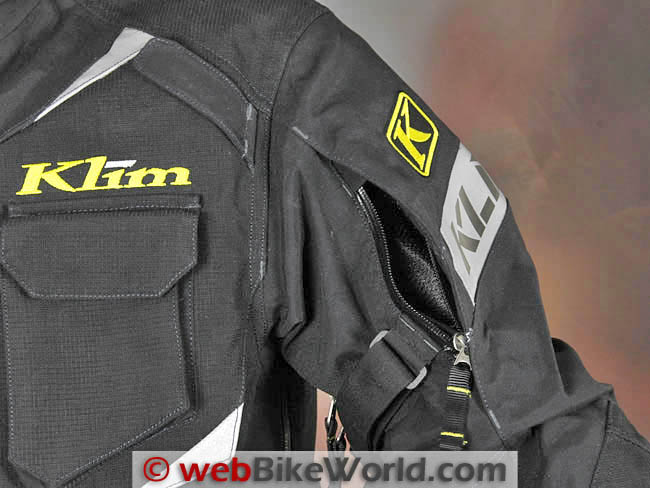
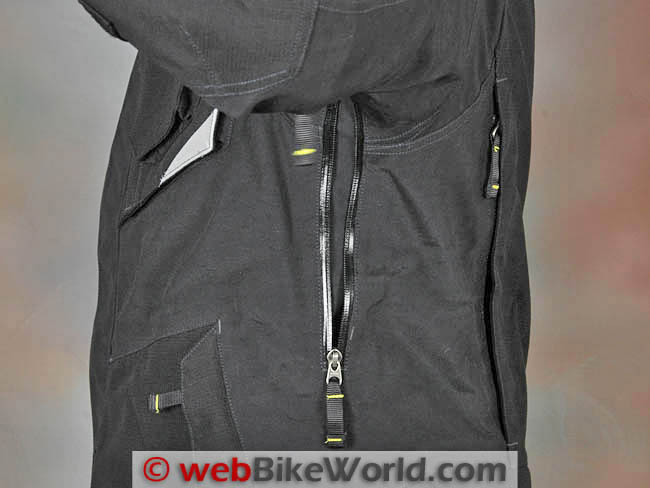
Badlands Pro Jacket Construction Features (Cont’d)
Armacor Cordura Kevlar Ripstop Panels
Klim says that the Armacor Cordura and Kevlar ripstop product is also used in “key external wear areas” on both the jacket and pants.
These areas include the outer elbows and forearms, shoulders, the entire back of the jacket and, strangely enough, the upper and lower front pockets.
I guess the pockets serve as both external wear areas and pockets can take a lot of beating too, depending on what they’re holding.
The ripstop pattern is a little difficult to discern in the photos on the black jacket and pants, but besides is protective abilities, it also adds to the slightly sinister look of the Badlands Pro.
Just by way of comparison, the Badlands Pro jacket and pants do not use the Superfabric abrasion panels which are found on the Rev’it Defender GTX.
Klim also said that the Badlands Pro jacket and pants have Gore-Tex stretch panels “incorporated into key flex zones”. The only “flex zones” I see that may use this material are narrow sections in back of the shoulders.
I couldn’t find any flex zones in the pants, but it’s hard to tell with all of that black fabric.
Ventilation
The Badlands Pro excels at ventilation, with a very well-designed system that provides outstanding yet subtle air circulation.
Looking at the jacket, you wouldn’t think the ventilation system is all that much different than any other 3/4-length jacket.
But there’s a big difference; where most of the venting systems work only in the minds of the advertising copy writers, the Klim system works where it counts — on the road.
All of the vents are covered with YKK waterproof zippers. Vents are located along the upper arm and the forearm but not on the chest.
It’s difficult to design front vents that will stay open when riding yet remain waterproof, especially when a bonded breathable membrane liner is involved.
So the Klim designers added a large zipper vent opening under the arms, which is both effective and helps improve ventilation even in light rain.
This is similar to the venting system found on the Aerostich Darien jacket (review) and we’ve always wondered why other motorcycle jacket manufacturers haven’t used a similar approach.
All I can say is that it works on the Darien and it works here.
The Badlands Pro also has dual vertical vents in the rear of the jacket, which help exhaust the air and prevent billowing when riding.
The Gore-Tex membrane that lives under the vents is cut to allow air to flow freely on to the rider, through the mesh jacket liner.
The venting system really works and, combined with the excellent breathability of the Gore-Tex Pro Shell, the Badlands Pro jacket is much more comfortable than you’d think in warm weather.
To summarize the Ventilation the Badlands Pro jacket has eight vents: four arm vents; two underarm vents and two rear exhaust vents.
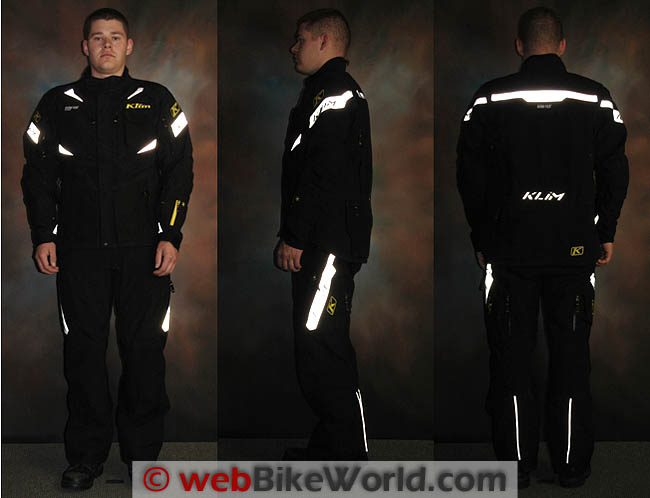
Reflectivity
Klim didn’t skimp on the genuine 3M Scotchlite “Industrial Grade” reflective panels on the Badlands Pro, as you can see in the photo above.
The material is nicely incorporated into the various design aspects of the jacket, helping to break up the black a little bit and adding a styling touch during the day and, of course, excellent visibility at night.
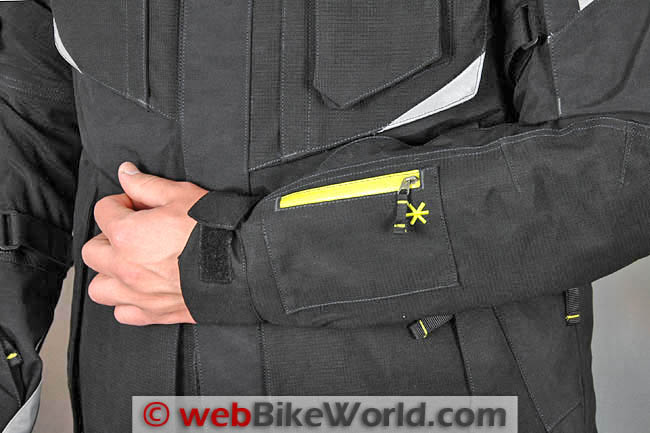
Pockets and Storage
The Badlands Pro jacket has plenty of storage, starting with a pair of nicely designed cargo pockets located on each side of the upper chest.
These pockets are cut at a slight angle with the extra material at the lower outer edges.
This keeps the center section of the jacket trim but the pockets provide a lot of storage capability. Each is secured with a vertical waterproof YKK zipper under a flap along the inside, towards the center of the chest.
The pocket on the right includes an internal plastic snap hook with a nylon carry bag that can be detached.
The pocket on the left has an internal plastic hook, the waterproof zipper and a bonus outer patch pocket large enough for most cell phones. All are waterproof by virtue of the Gore-Tex Pro Shell.
The pair of lower front pockets also have the waterproof YKK zipper located vertically towards the outside. Curiously, the pocket flaps on these point inwards towards the center of the rider.
It’s not an issue, but just something to note.
The left arm includes a small waterproof change pocket located down towards the cuff.
In the rear, the jacket has a very large waterproof cargo pocket across the lower back. The jacket is also ready for a hydration bladder, with hose routings on either side.
Inside the jacket are six more very handy pockets, all located as part of the mesh lining on each side.
One is a vertical zippered pocket; one is a horizontal zippered pocket and one is a mesh stash pocket with an elastic top and hook-and-loop closures.
This is repeated on both sides of the jacket. The vertical pocket also serves to hold the comfy Dow Corporation “Deflexion Siliconized Spacer Mesh” front chest armor.
To summarize, the Badlands Pro has 7 external pockets: two on the chest with one chest fast-access pocket; two hand pockets; one large rear cargo pocket and one sleeve change/ID pocket.
The jacket has six internal pockets (Klim says four but I’m counting the chest armor pocket as usable), including the two zippered and two mesh stash and a hidden passport pocket (that was hidden so well it took me a while to find it!).

Protection and Padding
I got ahead of myself a little here but just for the record, the jacket includes the excellent d3o back protector I mentioned.
Also, it includes the Dow chest protector that are both incorporated into the jacket design, the Badlands Pro also has d3o CE-Rated T5 Pro protectors in the elbows and shoulders.
The back protector is the d3o “Viper Pro Level II Back Armor”, with a Level 2 CE rating.
The elbow padding pockets are adjustable and overall, the armor really is very comfortable, all things considered.
The back protector and the chest protector don’t seem to affect the excellent ventilation in this jacket, another surprise.
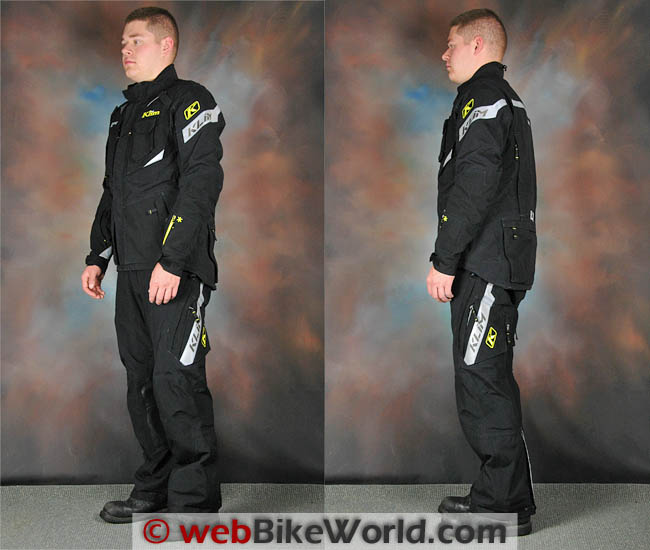
| The wBW Opinionator: Klim Badlands Pro Jacket | |
|---|---|
| Picks… | …and Pans. |
|
|
Conclusion
The Klim Badlands Pro jacket is one half of a rugged, tough, go anywhere and do anything outfit that is comfortable, well ventilated, sturdy, protective and feels like it will last forever.
I’d have given it our highest Five-Star rating, but the collar issues, the small pieces of hook-and-loop and the problematic arm adjusters knocked it back a notch. Let’s hope Klim fixes that in a running model change; a $900 jacket deserves better.
[UPDATE: I wish Klim had told us that we had a pre-production version of the jacket and about the changes that have been made; it would have significantly changed the outcome of this review.In any case, they are noted above and I have left my original narrative because we don’t have updated version of the jacket or pants to review. Sorry for any confusion this may cause.]
By the way, a $900 jacket also gets a more critical eye by webBikeWorld staff, thus the nitpicks.
But the bottom line here is that I don’t think there’s a more effective jacket for true adventure touring available today.
It leaves the Rev’it Defender GTX — a nice outfit — on the street and it even makes the BMW Rallye 3 outfit (review) seem more Strasse than Gelände.
You could buy a Badlands Pro jacket, beat the ever-lovin’ tar out of it for a decade and I bet dollars to doughnuts you’d look a lot worse than it!
| wBW Product Review: Klim Badlands Pro Jacket | |
|---|---|
| Manufacturer: Klim | List Price: $899.99 |
| Colors: Black or Black/Gray. | Made In: China |
| Sizes: S-3XL | Review Date: August 2011 |
|
Note: Item was provided by a retailer, distributor or manufacturer with these Terms and Conditions.
|
|
Owner Comments and Feedback
See details on submitting comments.
From “S.S.” (August 2011): “The debate continues to rage on regarding the protective abilities and abrasion resistance of different fabrics and armor.
And a potential buyer is forced to read everything possible and then make a decision based upon which argument one finds most compelling.
Unfortunately, until we have a definitive study comparing all of the fabrics and armor currently available, reviewers are forced to rely upon their own experience or private testing certifications.
And both of those may be subjective and not necessarily applicable to other riders in the real world.
It is not unusual, then, for reviewers to mostly gloss over the crash worthiness of a garment, and instead focus on the other features.
I think this does not serve the potential purchaser well, and when one has entered the rarified air of garments nearing the $1000 range, I do think more attention should be given to crash worthiness.
In regards to the $900 Klim jacket: I paid the same price for my Motoport Stretch Kevlar jacket, and it was custom made for my exact measurements. I chose it because of the protective qualities first, and then tailored it to my exact needs.
I got to choose the colors, the layout of the pockets, and the special features I wanted. Yes, it does require a zip out Gore Tex lining in heavy rain, but it also has the quad armor and the Kevlar fabric, which the Klim does not.
In addition, the collar has Velcro tabs to keep it open in hot weather, or I can just zip in the 4 inch wide mesh Kevlar zipper panel in the front for even more air flow.
It has no external logos at all, just a Cycleport label inside.
I have over 3,500 miles in it since I bought it, including extremely hot humid days and torrential downpours, and I couldn’t be happier with it.
There are other options at this price point. Thanks as always for a great magazine!”
Rick’s Reply: Just to note, the Klim Badlands Pro jacket is designed with about 80% focus on off-road activities and 20% on the street, probably the opposite of current selections from Motoport, Rev’it, etc., thus the different emphasis on features and functionality.
From “J.J.K.” (August 2011): “Thanks for your detailed review of the Klim Badlands Pro.
The price is steep even compared to other premium jackets, and you get to pay for the privilege of advertising Klim and Gore-Tex too.
I wonder how many other riders out here are turned off by billboard clothing? Lack of advertising is something I look for in clothing.”
Rick’s Reply: Actually, I’m not big on logos at all and always try to avoid them on my street clothing. But this outfit looks pretty cool to me and the logos give it a sort-of Dakar race look.
The riders and owners that inspired this look and that are the primary Klim customer are hard-core, off-road, adventure-touring Dakar Rally types.
Logos are all over those bikes, so they’re used to it and probably would thing something’s wrong without them!
I didn’t even think much about it, but looking it over, I could agree that the Klim logos may be a bit overdone.
But the combination of black, some yellow and the reflective strips gives it a very bad-in-a-good-way appearance that I like. So, as they say, “Taste is in the mouth of the swallower”!
From “M.C.” (August 2011): “A $900.00 jacket should make you a better rider and come with pockets stuffed with lottery tickets.
There are so many other choices out there that will do the same for less money. Snob appeal aside….what’s the point?”
Rick’s Reply: I agree the price is high, but the jacket definitely is not just snob appeal, it has way more performance than the el cheapo brands.
It’s also fully waterproof without a waterproof liner (which many riders demand and will pay extra for) and breathable and it will probably still be chugging along when the $500.00 jackets are unraveled threads on the side of the highway.
By the way, the Badlands Pro may seem expensive, but check out the Klim Adventure Rally jacket for $1,300.00! Makes the Badlands Pro seem like a bargain!
M.C.’s Reply 1: I have used MSR, Moose Racing and a few other “high end” jackets that will do everything that the Klim will do.
In this day and age I don’t know anyone that keeps clothing items more then just a few years anyways…except for us old coots that still have our Belstaff jackets from the 70s!
Can Klim really justify charging almost twice as much as MSR or Moose with the flaws you have pointed out? Don’t mind me…I’m just an old biker rambling on…
Rick’s Reply 1: Not to belabor the point…and I don’t want to sound like an apologist for Klim by any means. And, by the way, I do think the Badlands Pro is expensive.
But…honestly, I could not even come close to comparing the Badlands Pro or Klim Adventure Rally jacket to anything in the current MSR or Moose Racing catalog.
Nothing wrong with them, but it’s really apples/oranges, chalk/cheese.
It’s like comparing jeans and a T-shirt to Valentino Rossi’s leather race suit. Yep, they’re both categorized as “clothing”, but the differences are great.
The Gore-Tex Pro Shell fabric alone sets the Badlands Pro apart from anything else — and we’ve tried them all. It is surely responsible for some of the price difference, as is the lifetime guarantee.
Think about that (and to some riders, this alone is worth the cost): the product is guaranteed for life to remain waterproof and to perform.
I don’t begrudge people that buy the high-end Rev’it, Klim, Halvarsson’s, Rukka (how about that £999/$1650.00 Armas jacket?), etc. gear.
This gear really is different and it’s made with the latest, greatest, highest-tech fabrics and ingredients for maximum performance.
This is absolutely not a Firstgear, Joe Rocket, Icon, et al equivalent that somebody threw a big price tag on just to attract the squids.
In fact, it’s just the opposite — the high prices turn away the posers, and the people who really need this type of performance gear have no trouble at all paying for it. They want it — demand it, in fact; I know this because I’ve seen it.
Again, it may not be for me — honestly, I don’t need that level of guaranteed, count-on-it performance.
But some riders do and there is definitely a market for it or Klim and Rukka and Rev’it, etc., wouldn’t be taking the time and making the investment to get this stuff to market.



